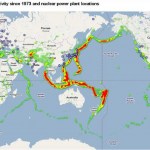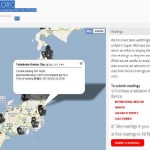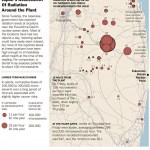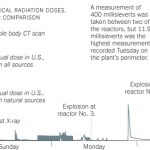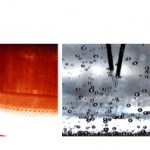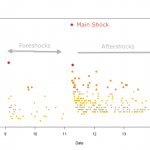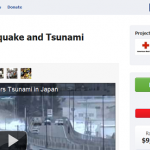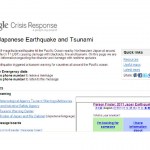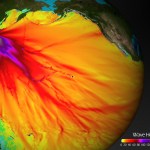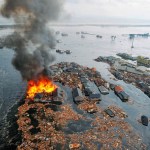Japan Disaster Relief 2011
Disaster relief for Japan has taken on many forms, and I applaud artists when they use their talents and their broad outreach to help the victims and their families. The band Linkin Park has responded in their own way, using graphic design guided by their fans.
This effort is part of the "Music for Relief" campaign.
You can view the CNN broadcast here about their design.
Linkin Park - Not Alone Lyrics
I break down, fear is sinking in
The cold comes, racing through my skin
Searching for a way to get to you
Through the storm you...
Go, giving up your home
Go, leaving all you've known
You are…
This map shows a heatmap of 175,000 4.5+ magnitude earthquakes since 1973 based on data from the USGS (United States Geological Survey). And worldwide locations of nuclear power stations using information from the IAEA (International Atomic Energy Agency).
An alarming number of nuclear power plants are located within active earthquake zones. Will this be a clarion call for more stringent safety standards?
According to the maptd blog:
Following the incidents at nuclear power plants in Japan after the earthquake I was wondering which power stations around the world are near active…
This article was co-authored with Dr. Rama Hoetzlein, Assistant Professor, Department of Architecture and Media Technology at the Aalborg University at Copenhagen. Dr. Hoetzlein prepared the graphic.
With increasing concern about radiation exposure in Japan and beyond, you might wonder: How much radiation am I getting? It depends...
Note that Dr. Hoetzlein and I are not experts in nuclear engineering; this graphic has been prepared using authoritative source material and is intended as a general guide.
This visualization shows a map of low level ionizing radiation levels received from…
Crowd sourcing is now being used to report, in real time, reliable data of Japan's radiation levels. According to the developers:
We too have been watching events unfold in Japan. We have created this site in an effort to display the reliable data readings as they become available. While we are careful to evaluate new data sources, we welcome new reliable data from those on the ground in this crisis.
Data Sources
While we hope to gather data via our own website, we recognize the efforts of others out there who are actively seeking and parsing data and making it available for others to…
Source.
Local produce, such as milk and spinach, are beginning to show potentially alarming signs of radiation up to 90 miles away from the damaged Fukushima nuclear power plants, according to Japanese officials. Will this be temporary or of long range concern?
According to an article in The New York Times:
TOKYO -- The government said Saturday that it had found higher than normal levels of radioactive materials in spinach and milk at farms up to 90 miles away from the ravaged nuclear power plants, the first confirmation by officials that the unfolding nuclear crisis has affected the…
Find out how to invest in energy stocks at EnergyAndCapital.com.
The ongoing human tragedy in Japan, now centered on the Fukushima nuclear power plants, highlights the need for innovative approaches to meeting our energy needs. This "peak oil clock" could provide some perspective into how much oil the world is consuming. Will this be a wake up call?
As I write this, the year to date consumption is more than 5.5 billion barrels.
Source.
Engaged in the tragedy in Japan unfolding since March 11, getting reliable, consistent information can seem to be an impossible task. Do you ever feel like this hapless character trying to absorb information coming in so fast and furious, it's like trying to drink from a fire hose?
Getting accurate, current information about the disaster in Japan is much easier now, with the introduction of a special "wiki" maintained by the Federation of Earth Science Information Partners. Thanks to my colleague Dr. Sheryl Beach , Associate Professor of Geography and Earth Science at George…
Source.
In a matter of hours, it will be exactly one week since the devastating earthquake struck Japan (Friday, March 11, 2011 at 12:46:23 AM (EST)). In honor of the victims and their families, let's think Japanese and offer whatever we can to help them through this tragedy so that they can emerge strong and resilient.
Each of us has our own way to extend our thoughts to those in need. I have included below a number of ways, including the chant of Nichiren Buddhism (in the spirit of "think Japanese") that has touched my life, as well as a number of practical ways to give.
æ¥è®ç³»è«¸å®æ´¾…
Radiation levels at the Fukushima Daiichi nuclear plant have been reported to significantly increase on Tuesday during a fire near reactor No. 4. Fortunately, these levels dropped rapidly after the fire was extinguished. The measured unit, in millisieverts, is difficult to put into perspective in our daily lives. How do these levels compare to a whole body CT scan?
In an article in The New York Times {graphic above} today, these levels are put into perspective.
As you can see, there is only one data point significantly above 10 millisieverts (per hour), the amount equivalent to a whole…
Photograph of the Chornobyl environment in the former "Red Forest" region, taken in June 1998, some 700 meters west of Reactor 4 in an area remediated by removal and burial of top soil and dead pine trees. Radiation in this region today is 2-4 millirems per hour at a height of 1 meter.
Decades after the infamous Chernobyl nuclear power plant disaster, some surprises have emerged: their wildlife seems to be thriving, with little evidence of increased mutation rates. NPR aired a fascinating interview with biologist Robert Baker. What are the implications for Japan?
Robert Baker is:
a…
Following the news about the damage and explosions at the Fukushima nuclear power plants has been distressing and confusing. Major news media outlets report high levels of released radiation, while nuclear engineers have a different opinion. Who's right?
According to The New York Times report (Mar. 15): {my emphasis}
At least 750 workers evacuated on Tuesday morning after a separate explosion ruptured the inner containment building at reactor No. 2 at the Daiichi plant, which was crippled by Friday's earthquake and tsunami. The explosion released a surge of radiation 800 times more…
Magnitude of earthquakes (M5-6=small yellow circles, M6-7 orange circles, M7+ large red circles) off the coast of Honshu, 9-14 March.
Geologist Chris Rowan's Scientific American article, "Japan earthquake: The explainer" clarifies some very important points about Japan's earthquakes {highly recommended reading.} Can we learn from this?
Take a look at these data of foreshocks and aftershocks. It tells an extraordinary story: on March 9, there was an earthquake of magnitude greater than 7.0, followed by dozens of weaker events (magnitude 5 to 6) over the next 48 hours, just before the major…
I've been thinking a lot about how to support victims and their families in Japan since the earthquake and tsunami struck last Friday.
Ben Parr at Mashable gives us some simple, concrete ways we can help in his article, "Japan Earthquake & Tsunami: 7 Simple Ways to Help." Please do what you can.
1. Text to Donate
The American Red Cross has once again launched a texting campaign to raise money for relief efforts in the Pacific region. Last year, the Red Cross was able to raise over $20 million for Haiti relief through simple text donations.
If you would like to donate to the American Red…
Lady Gaga just announced to her close to 9 million Twitter followers that she has designed a "Prayer bracelet" to raise funds for Japan.
What a brilliant way for a celebrity to raise funds for an important humanitarian project. Go "little monsters"!
You can order one, or more, here.
Why the connection to Japan?
UPDATE MAR. 17:
>$250,000 raised from Lady Gaga's bracelets!
@ladygaga Lady Gaga
Monsters: in just 48 hrs you've raised a quarter of a million dollars for Japan Relief. RT: http://bit.ly/f0aYwZ. It's important we help. X
On Friday, along with a purchase link and photo of the…
Google has launched a Person Finder for anyone looking for someone affected by Japan's 2011 Tsunami, or anyone with information about someone there.
As of this moment, this site is tracking close to 60,000 records. Importantly, you can find at a single website emergency telephone numbers and message boards, including the most current information about transportation in Japan.
I hope that you find this resource useful as Japan begins its recovery from this devastation.
Below is an overview; the live links can be found at the Google Person Finder site here. It is available in both English…
Uploaded by NOAAPMEL on Mar 11, 2011
Propagation of the March 11, 2011 Honshu tsunami was computed with the NOAA forecast method using MOST model with the tsunami source inferred from DART® data. From the NOAA Center for Tsunami Research, located at NOAA PMEL in Seattle, WA. See http://nctr.pmel.noaa.gov/honshu20110311
Amidst the flurry of our 24 hour news cycle, with the pettiness of the U.S. National Football League clashes {is it not a game, after all?}, and intense debates on union rights in Wisconsin, it's time for some perspective: we are all connected, and "mother nature" does not…
NOAA just released this graphic displaying their best estimates of how far and high high the tsunami waves will travel after Japan's devastating earthquake yesterday. How far, how high will it go?
Tsunami Wave Height Model Shows Pacific-Wide Impact
Model runs from the Center for Tsunami Research at the NOAA Pacific Marine Environmental Laboratory show the expected wave heights of the tsunami as it travels across the Pacific basin. The largest wave heights are expected near the earthquake epicenter, off Japan. The wave will decrease in height as it travels across the deep Pacific but grow…
Photo source (MSNBC).
With the terrible news of an earthquake and subsequent tsunami in Japan this morning, my thoughts are with the victims and their families. Is this more evidence of "Global Weirding?
TOKYO -- A magnitude 8.9 earthquake slammed Japan's northeastern coast Friday, unleashing a 13-foot tsunami that swept boats, cars, buildings and tons of debris miles inland and prompting a "nuclear emergency."
At least 40 people were killed and there were reports of several injuries in Tokyo, hundreds of miles away, where buildings shook violently through the main quake and the series…
